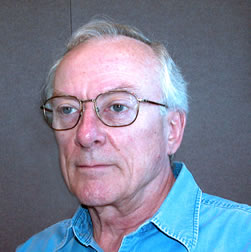| |
| |
| Frederick A. Miles, Ph.D., Senior Investigator |
 |
Dr. Miles received his B.Sc. from Leeds University, England, in 1962, and his
D.Phil. from the University of Sussex, England, in 1971. After a postdoctoral
fellowship in the Laboratory of Neurophysiology at the NIMH, he held various
positions in that Institute before joining the NEI as an Investigator in 1980.
His laboratory uses the eye movements elicited at short latency by visual
inputs to infer the early cortical processing of visual motion and disparity.
|

|
Staff:
Research Interests:
Dr. Miles's laboratory studies the visual control of human eye movements, concentrating on three reflexes that have been postulated to help stabilize the eyes of the moving observer. Two of these reflexes respond to the patterns of optic flow experienced by the observer during translational disturbances and the third responds to small binocular misalignments (disparity). Lesions and electrophysiology in monkeys indicate that, despite their short latency, all 3 reflexes are mediated by the medial superior temporal area of cortex (MST), and share many features in common leading to the suggestion that they constitute a single family of reflexes. Recent research has concentrated on the fundamental properties of the underlying sensory detectors, showing that they respond to filtered versions of the visual input and sense the energy in the stimulus. By manipulating the harmonic content of the visual stimuli it has been possible to uncover powerful nonlinear interactions, some of which are local - and result in a winner-take-all situation that favors the harmonic of highest contrast - whereas others are more global - and result in a divisive normalization that renders the reflexes relatively insensitive to the physical size of the stimulus. Observations like these have led to the suggestion that these eye movements are a powerful probe for elucidating the early cortical processing of visual motion and disparity.
|
Selected Recent Publications:
KODAKA, Y., SHELIGA, B. M., FITZGIBBON, E. F. & MILES, F. A. (2007) The vergence eye movements induced by radial optic flow: some fundamental properties of the underlying local motion detectors., Vision Research 47, 2637-2660.
TAKEMURA, A., MURATA, Y., KAWANO, K. & MILES, F. A. (2007) Deficits in Short-latency Tracking Eye Movements following Chemical Lesions in Monkey Cortical Areas MT and MST., J. Neurosci. 27, 529-541.
SHELIGA, B. M., FITZGIBBON, E. F. & MILES, F. A. (2007) Human vergence eye movements initiated by competing disparities: evidence for a winner-take-all mechanism., Vision Research 47, 479-500.
SHELIGA, B. M., FITZGIBBON, E. F. & MILES, F. A. (2006) Short-latency disparity vergence eye movements: A response to disparity energy., Vision Research 46, 3723-3740.
SHELIGA, B. M., CHEN, K. J., FITZGIBBON, E. F. & MILES, F. A. (2006) The initial ocular following responses elicited by apparent motion stimuli: reversal by inter-stimulus intervals., Vision Research 46, 979-992.
MIURA, K., MATSUURA, K., TAKI, M., TABATA, H., INABA, N., KAWANO, K., & MILES, F. A. (2006) The visual motion detectors underlying ocular following responses in monkeys., Vision Research 46, 869-878.
SHELIGA, B. M., KODAKA, Y., FITZGIBBON, E. F. & MILES, F. A. (2006) Human ocular following initiated by competing image motions: evidence for a winner-take-all mechanism, Vision Research 46, 2041-2060.
All Selected Publications
Contact Information:
Dr. Frederick A. Miles
Oculomotor Control Section
Laboratory of Sensorimotor Research, NEI
Building 49 Room 2A50
49 Convent Drive MSC 4435
Bethesda, MD 20892-4435
Telephone: (301) 496-2455 (office),
(301) 402-0511 (fax)
Email: fam@lsr.nei.nih.gov
|
|















